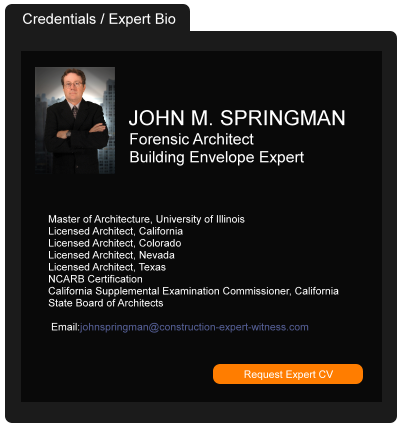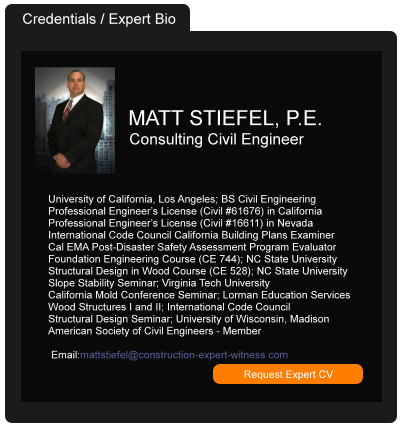Reinventing the Building Envelope – Interview with Gordon A Geddes
September 01, 2016 —
Aarni Heiskanen – AEC BusinessIn this interview with Gordon A Geddes, CEO of Lynx Systems, we talk about reinventing the building envelope. Gordon also gives great advice to innovators in the construction industry.
Read the court decisionRead the full story...Reprinted courtesy of
Aarni Heiskanen, AEC BusinessMr. Heiskanen may be contacted at
aarni@aepartners.fi
Reconstructing the Francis Scott Key Bridge Utilizing the Progressive Design-Build Method
June 04, 2024 —
Lisa D. Love - The Dispute ResolverHaving awakened on the morning of March 26 to the devastating news of the collapse of Baltimore’s Francis Scott Key Bridge after being struck by the Dali, a 984 length /52 beam foot cargo container ship, I thought of the many times I crossed the bridge as a child growing up in Washington, D.C. I also recalled Montgomery Schyler’s comments on the opening of the Brooklyn Bridge, when he stated that “the work which is likely to be our most durable monument, and to convey some knowledge of us to the most remote posterity, is a work of bare utility; not a shrine, not a fortress, not a palace, but a bridge.”
I thought of the beauty of New York’s Mario Cuomo Bridge, a 3.1-mile cable-stayed twin-span bridge with eight traffic lanes, bicycle and pedestrian paths, six lookout points and room for future rapid transit. It was completed in 2018 and constructed under a design-build procurement model[i] at a cost of $3.98 billion. Accelerated bridge construction (ABC) techniques were utilized in its construction. ABC techniques employ innovative planning, design, materials, and construction methods in a safe and cost-effective manner to reduce the on-site construction time that occurs when building new bridges or replacing and rehabilitating existing ones. ABC techniques improve site constructability, total project delivery time, work-zone safety for the traveling public and traffic impacts, on-site construction time, and weather-related time delays.[ii]
I also thought of the gracefulness of Boston’s Leonard P. Zakim Bunker Hill Memorial Bridge, a 0.27-mile hybrid cable-stayed steel and concrete bridge with pedestrian and bicycle access that holds 10 lanes of traffic. The Zakim Bridge was completed in 2004 at a cost of approximately $100 million as part of the $24.3 billion Big Dig.[iii] Despite its elegant, streamlined appearance, the bridge was designed to be exceptionally strong, withstand winds over 400 miles per hour and endure a magnitude 7.9 earthquake.[iv]
Read the court decisionRead the full story...Reprinted courtesy of
Lisa D. Love, JAMS
North Carolina Supreme Court Addresses “Trigger of Coverage,” Allocation and Exhaustion-Related Issues Arising Out of Benzene-Related Claims
January 04, 2023 —
White and Williams LLPOn December 16, 2022, the North Carolina Supreme Court decided Radiator Specialty Co. v. Arrowood Indem. Co., 2022 N.C. LEXIS 1122 (Dec. 16, 2022), in which it addressed coverage issues arising out of claims by individuals alleging injury from exposure to benzene contained in the insured’s products. Affirming in part and reversing in part the intermediate appellate court’s decision, the court held: (1) an “exposure trigger” applied; (2) defense and indemnity costs were subject to pro-rata allocation; and (3) vertical exhaustion applied to the duty to defend under certain umbrella policies. Two justices concurred in part and dissented in part.
I. Background
In Radiator Specialty, the insured (RSC) was named in hundreds of underlying suits arising from individual plaintiffs’ alleged exposure to benzene contained in its products. Between 1971 and 2012, RSC was insured under primary, umbrella and excess liability policies issued by various insurers. In 2013, RSC sued the insurers in North Carolina state court, seeking coverage for approximately $45 million in defense and indemnity costs incurred for the underlying claims. In 2016, the trial court decided motions for summary judgment on a number of coverage issues. Following a bench trial in 2018, the trial court entered final judgment, which required the insurers to reimburse $1.8 million of RSC’s past costs. The rulings were appealed to the North Carolina Court of Appeals, which issued a decision in 2020. In 2021, the North Carolina Supreme Court granted RSC’s and certain insurers’ petitions for discretionary review of the Court of Appeals’ decision.
Read the court decisionRead the full story...Reprinted courtesy of
White and Williams LLP
How Finns Cut Construction Lead Times in Half
December 17, 2024 —
Aarni Heiskanen - AEC BusinessRakennustieto organized a Q&A on December 5, 2024, titled “Halving Construction Lead Times—Responsible or Irresponsible?” The discussion focused on speeding up residential construction and renovations.
The experts answering questions were representatives from two Finnish contractors (COfLOW and Fira), a client organization (HOAS), a building materials retailer (STARK), and a research institute.
Can you halve construction lead time without sacrificing quality?
Jaana Matilainen of Rakennustieto asked the panelists whether halving construction time is a realistic goal today, whether they can provide any examples, and if the speed-up has increased or decreased quality.
Read the court decisionRead the full story...Reprinted courtesy of
Aarni Heiskanen, AEC BusinessMr. Heiskanen may be contacted at
aec-business@aepartners.fi
Five Steps Employers Should Take In the Second Year Of the COVID-19 Pandemic
March 29, 2021 —
Laura H. Corvo - White and Williams LLPFor the past year, employers faced unprecedented difficulties as they navigated the twists, turns and ever-present challenges the COVID-19 pandemic dished out. A year later, new challenges face employers. The promise of vaccines, the fear of new variants, and the realization that “normal” will never look quite the same, leave many employers to wonder: “what next?”. As employers prepare to enter the second year of the COVID-19 pandemic, here are five things they should plan to do.
1. Update Workplace Safety Measures
At the onset of the pandemic, employers struggled to understand the safety obligations involved in preventing the spread of COVID in the workplace. As we approach the second year of the pandemic, clearer legal standards and better science exist requiring employers to update the steps they are taking to keep their workplaces safe.
Read the court decisionRead the full story...Reprinted courtesy of
Laura H. Corvo, White and Williams LLPMs. Corvo may be contacted at
corvol@whiteandwilliams.com
Homeowner's Mold Claim Denied Due to Spoilation
April 20, 2016 —
Tred R. Eyerly – Insurance Law HawaiiThe trial court's issuance of summary judgment to the insurer for mold and water damage was upheld on appeal. Schwartz v. Encompass Indem. Co., 2016 Mich. App. LEXIS 551 (Mich. Ct. App. March 15, 2016).
The contractor was demolishing a portion of the insured's home when he discovered water damage and what appeared to be mold. The contractor believed this damage was due to improper roof installation and leaks around the windows. Further demolition was done to water-damaged portions of the home.
The insured filed a claim with Encompass for mold and "over-demolition." When Encompass's adjuster inspected the home, none of the alleged mold-affected material was present because it had been removed from the site by the contractor. The claims were denied.
Read the court decisionRead the full story...Reprinted courtesy of
Tred R. Eyerly, Insurance Law HawaiiMr. Eyerly may be contacted at
te@hawaiilawyer.com
It’s Too Late, Lloyd’s: New York Federal Court Finds Insurer Waived Late Notice Defense
June 05, 2023 —
Latosha M. Ellis & Janine A. Hanrahan - Hunton Insurance Recovery BlogA New York federal judge recently ruled that an insurer waived its late notice defense because a generic reservation of rights was insufficient to preserve it. As a result, the policyholder’s claim was preserved despite being submitted more than three months after the loss—a delay which would ordinarily be fatal under New York law. The decision underscores the importance both of timely submission of claims and careful attention to reservation of rights letters.
Background
Mave Hotel Investors LLC (“Mave”) owns a small hotel in Manhattan that was insured by Certain Underwriters at Lloyd’s, London (“Lloyd’s”). From October 2017 to October 2020, Mave contracted with a housing network to temporarily house homeless families and their children in the hotel. When the contract with the housing network terminated in October 2020, Mave alleged that the rooms were severely damaged and that it had to pay $1.4 million to repair them.
Reprinted courtesy of
Latosha M. Ellis, Hunton Andrews Kurth and
Janine A. Hanrahan, Hunton Andrews Kurth
Ms. Ellis may be contacted at lellis@HuntonAK.com
Ms. Hanrahan may be contacted at jhanrahan@HuntonAK.com
Read the court decisionRead the full story...Reprinted courtesy of
Pennsylvania Superior Court Tightens Requirements for Co-Worker Affidavits in Asbestos Cases
November 26, 2014 —
Jerrold P. Anders & Tonya M. Harris – White and Williams LLPIn Krauss v. Trane US Inc., 2014 Pa. Super. 241, --- A.3d --- (October 22, 2014), the Superior Court of Pennsylvania held that a witness affidavit does not create a genuine issue of fact to defeat summary judgment when it reflects only a presumption and belief that certain products contained asbestos. Moreover, when an affidavit fails to demonstrate plaintiff’s frequent, regular, and proximate exposure to a specific defendant’s asbestos-containing product, summary judgment will be granted.
The Executor of the Estate of Henry M. Krauss filed two lawsuits against forty-nine defendants in the Philadelphia Court of Common Pleas. Plaintiff alleged that Mr. Krauss, a bricklayer from 1978 to 1983, was occupationally exposed to asbestos and developed mesothelioma. Various defendants moved for summary judgment based on insufficient product identification. The trial court granted summary judgment in favor of the defendants because the co-worker affidavits failed to show that: (1) Mr. Krauss worked in proximity to the defendants’ products; (2) the products contained asbestos during the relevant period; or (3) Mr. Krauss inhaled asbestos fibers from the products.
Reprinted courtesy of
Jerrold P. Anders, White and Williams LLP and
Tonya M. Harris, White and Williams LLP
Mr. Anders may be contacted at andersj@whiteandwilliams.com; Ms. Harris may be contacted at harrist@whiteandwilliams.com
Read the court decisionRead the full story...Reprinted courtesy of


































































